
Making a 1/12 scale horse – part 2
Continuing work on the 1/12 scale model horse. Once I removed the mane last time and saw the slit in the neck, I thought it might be easier to leave the slit to add the mane. I could glue the hair deeper into the body for a more secure bond. The slit does go to the top of the head, so I’ve cleaned it out and widened it to the withers.
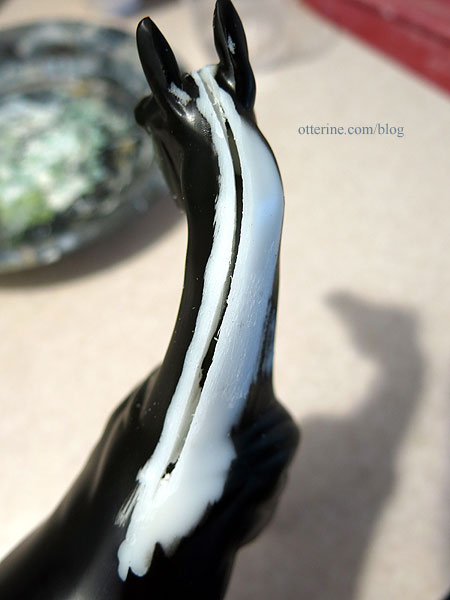
I used the Dremel to remove the tail nub left behind from breaking it off.
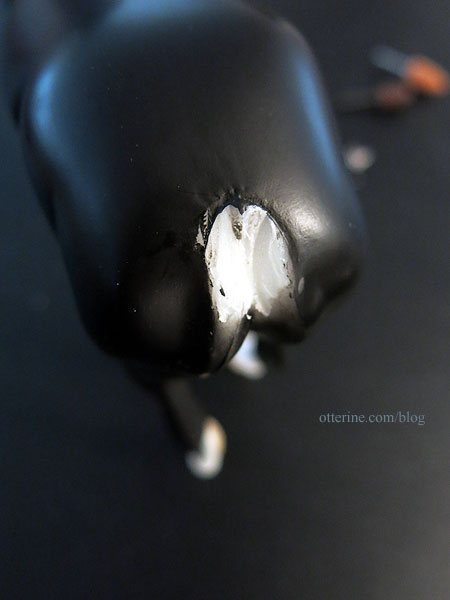
I then sanded the tail area. I’ll be repairing the area when I attach the tail support so I didn’t worry about the exact shape.
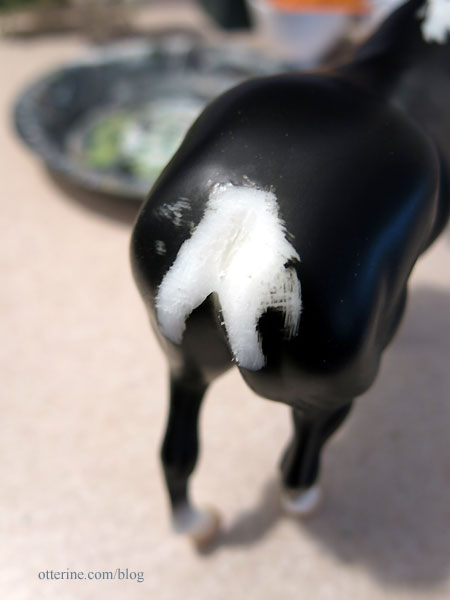
Here are the three bits I used in the process. The Dremel did melt the plastic as I worked, so I was sure to use protective glasses and a mask. I also made quick cuts and pulled the melted plastic as I worked.
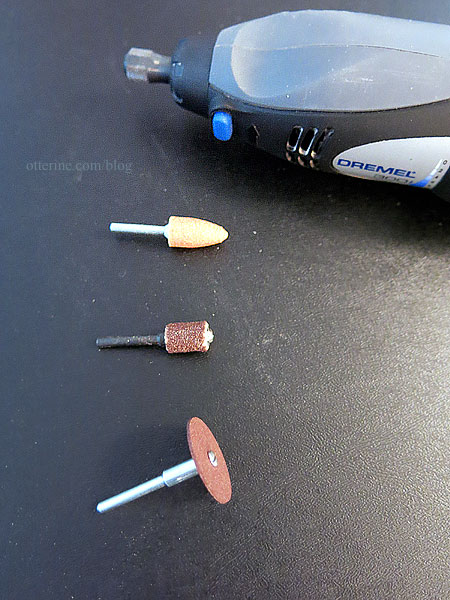
I drilled holes in the nostrils with a pin vise.
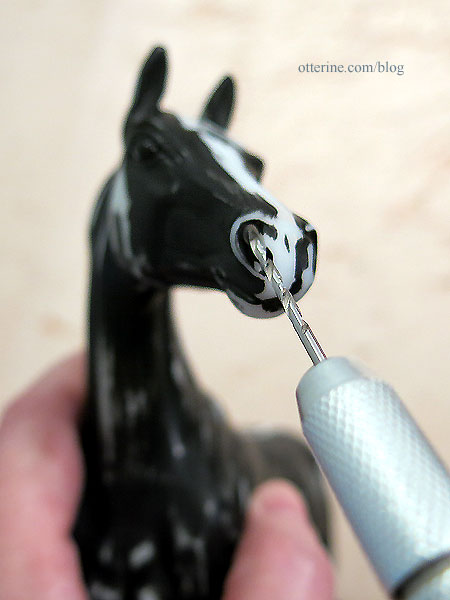
The one on the left has been drilled and the one on the right is original. You can already see a difference in the realism.
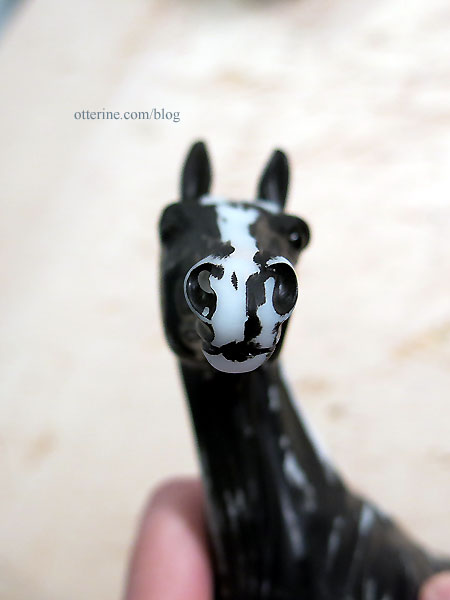
I fine-tuned the mouth with an X-Acto blade.
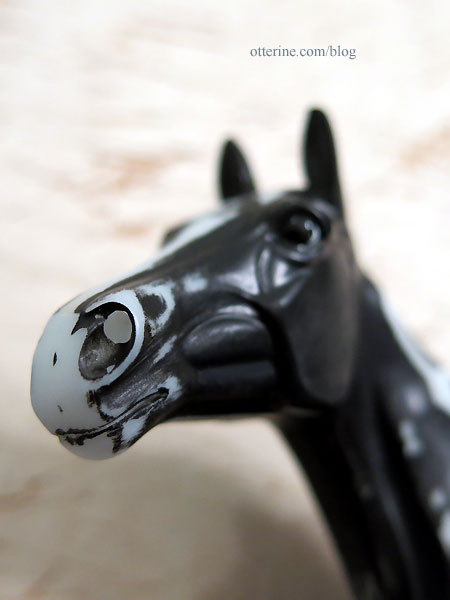
I sanded the few bad places from the deconstruction and then wet sanded the whole horse by hand with 320 grit. The finish on the plastic was very smooth and I wanted to make sure I had a good grip for the primer. I also removed the molded copyright from the inner thigh, random mold lines, and any other imperfections in the manufacturing process.
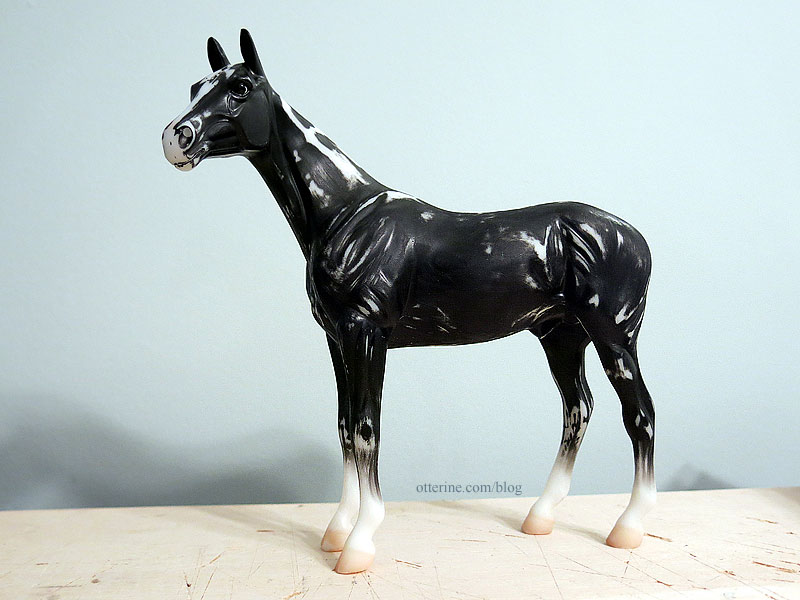
Categories: Animals and birds, Ivy Hollow RFD
February 11, 2019 | 0 commentsMaking a 1/12 scale horse – part 1
I’ll be starting with a 1:12 scale Breyer Thoroughbred. Adding flocking or fur adds bulk, so I thought I would start with the leanest horse model available. Of course, you can scrape down a model before flocking as well but I’d rather keep it as simple as possible.
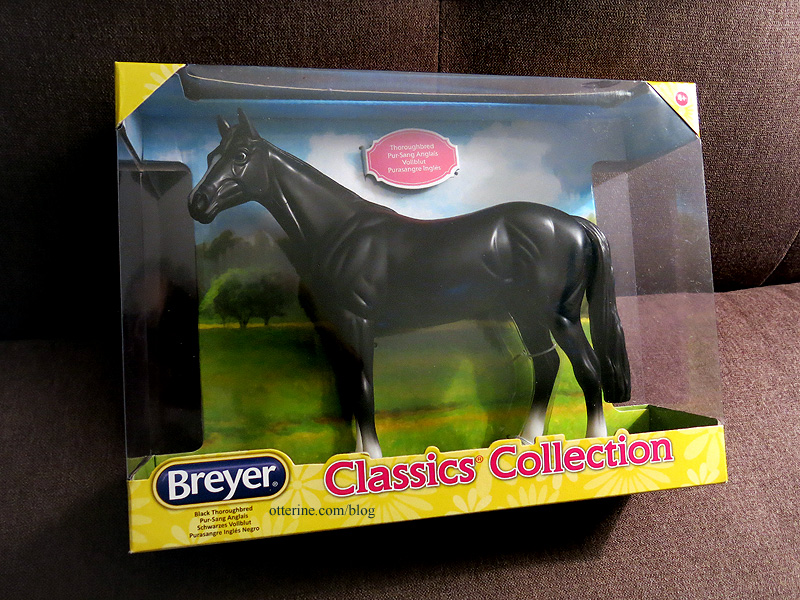
I picked up a set of diamond burrs for my Dremel to help with the deconstruction (as an Amazon Associate, I earn from qualifying purchases).
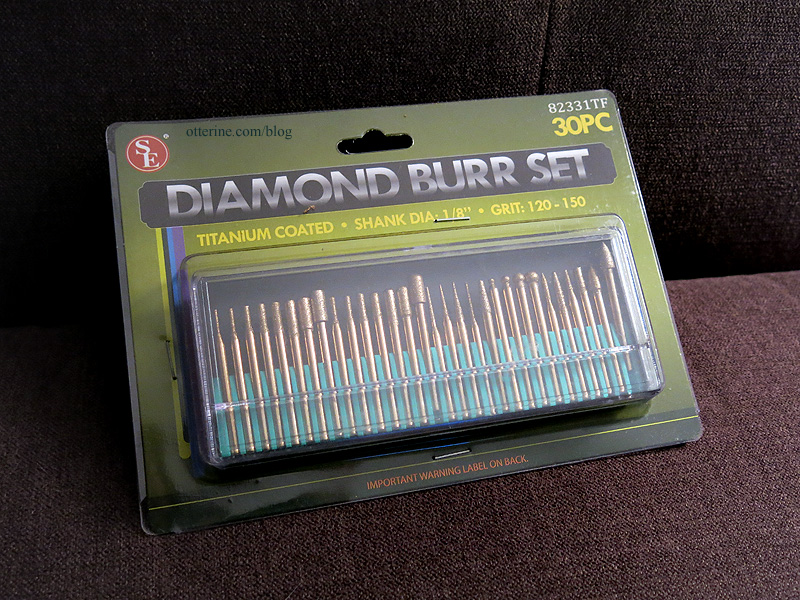
I found a great tutorial about removing the tail and building up with Apoxie Sculpt, so I picked that up as well even though I plan on having a mohair mane and tail (as an Amazon Associate, I earn from qualifying purchases).
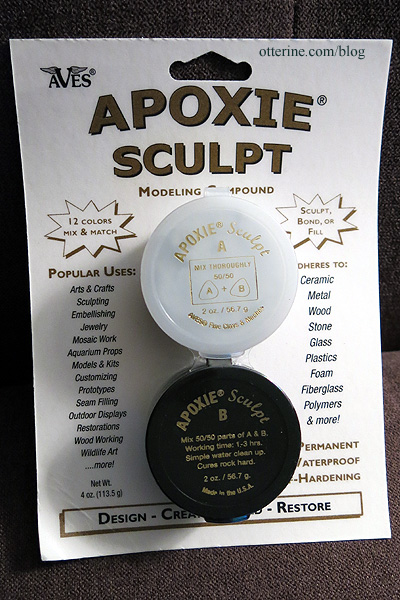
After the deconstruction and any necessary remodeling, I will begin with painting. I’ve always had a fondness for roan horses, so I might give that a go. A friend sent me a fabulous set of brushes and clay tools called a Bundle Monster that will be invaluable here.
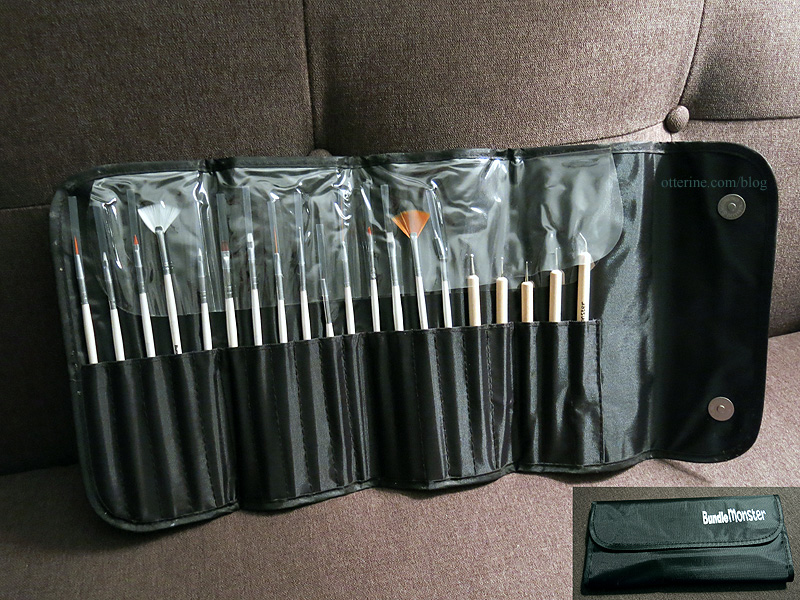
In the time since I bought the horse, the plastic mane had lifted from the neck. It made it easier to wedge in some pliers to pry off the mane.
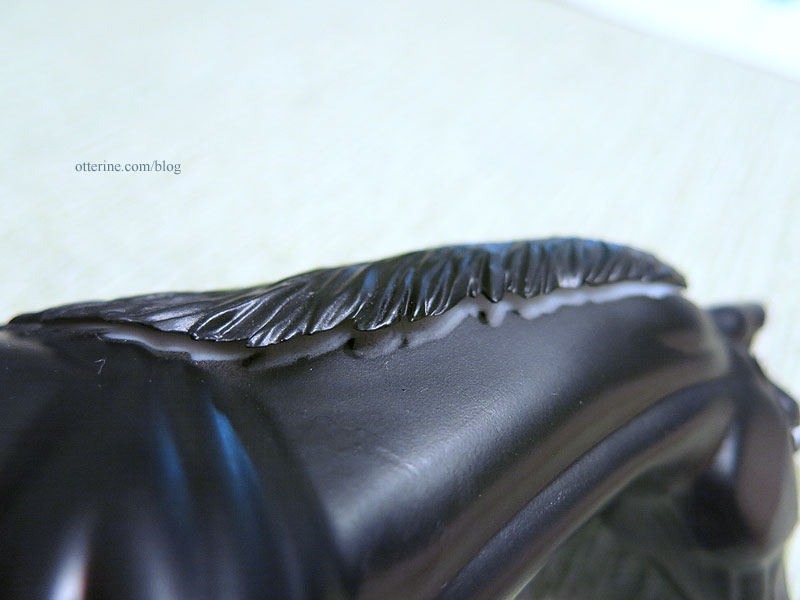
One thing I didn’t like about the plastic mane from the beginning was that it was formed on the side away from the direction of the horse’s gaze. Removing it for a mohair mane means I can style the hair toward the side I prefer.
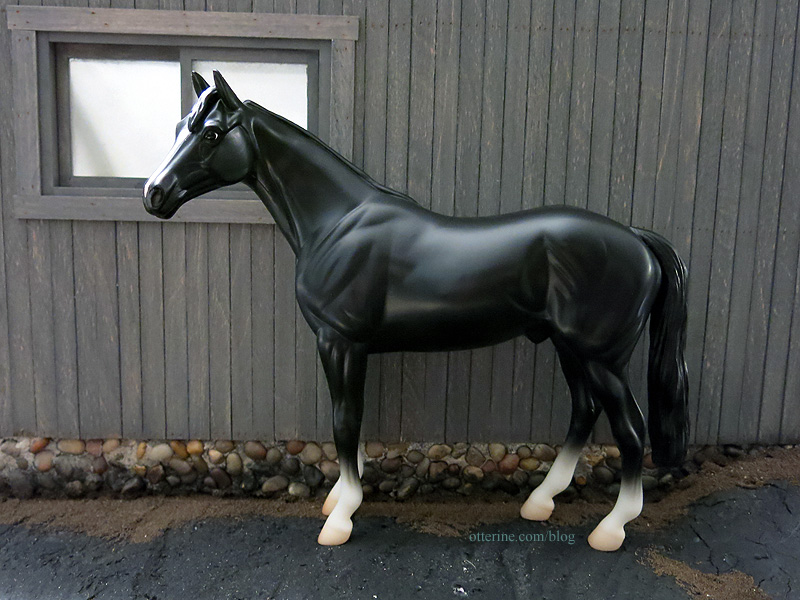
The nostrils might benefit from drilling in a deeper hole and the mouth could use some fine-tuning. I’ll need to sand the mold line on the tip of the snout.
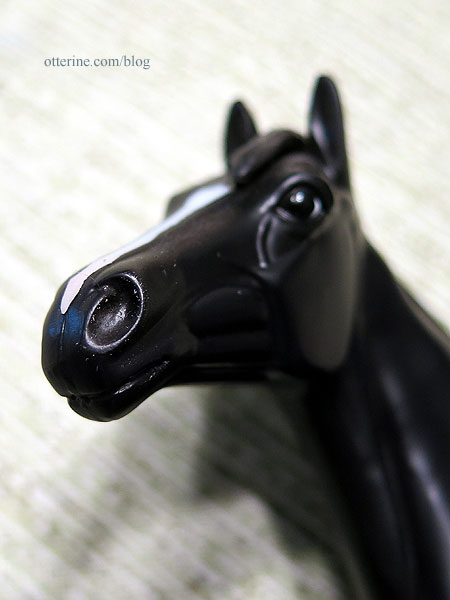
The eyes are great, so I will take care not to paint over those. The front mane has come detached from the small contact points as well.
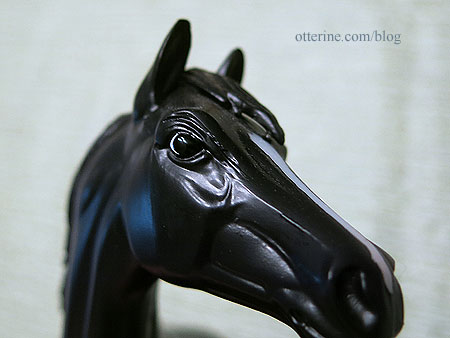
I cleaned up the spine with a utility blade and will fine tune by sanding. The gap will need to be filled, though it might be a good way to add the mane more securely. I’ll think on that a bit. I need to replace the putty I bought three years ago since I don’t want to take the chance that it has gone bad.
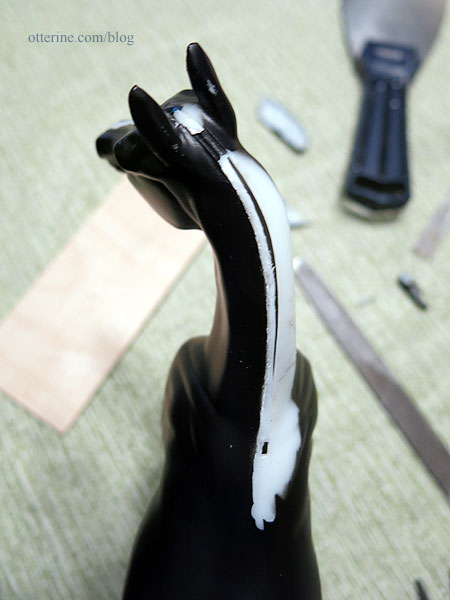
The tail was easy enough to lift and break off since it had no contact points with the legs. I’ll need the Dremel to cut away the remaining excess, but that’s for another day.
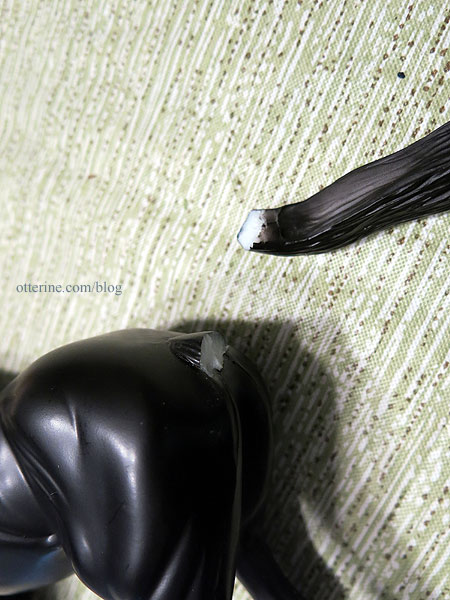
Categories: Animals and birds, Ivy Hollow RFD
February 4, 2019 | 0 comments
NOTE: All content on otterine.com is copyrighted and may not be reproduced in part or in whole. It takes a lot of time and effort to write and photograph for my blog. Please ask permission before reproducing any of my content. (More on copyright)
Categories:

Mail Wagon – part 10
Continuing work on the mail wagon. As you saw last time, I had primed the wagon wheels. On the hubs, I used Rust-Oleum Aluminum Primer, which is light grey. It bonds specifically to aluminum, and an aluminum primer was recommended in the instructions for the doctor’s buggy.
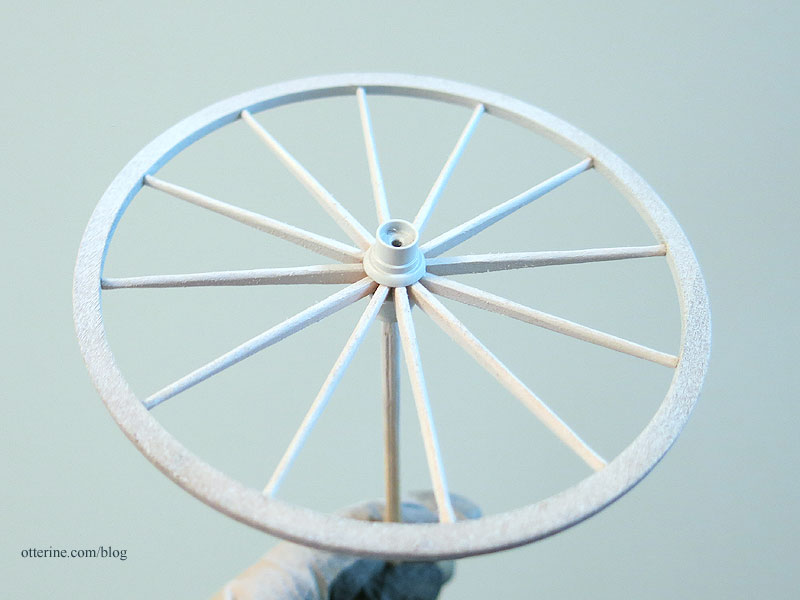
I then used plain flat grey Rust-Oleum primer. As you can see, the wheels are rather fuzzy.
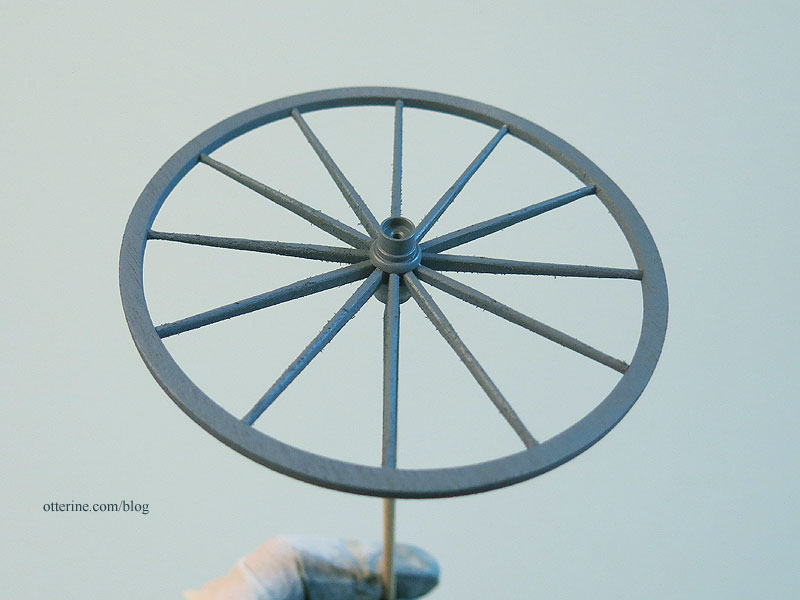
Sanding after priming a first coat always helps smooth the fibers away. Then a second quick spray of the same grey primer and they are now ready for final color when I get there….
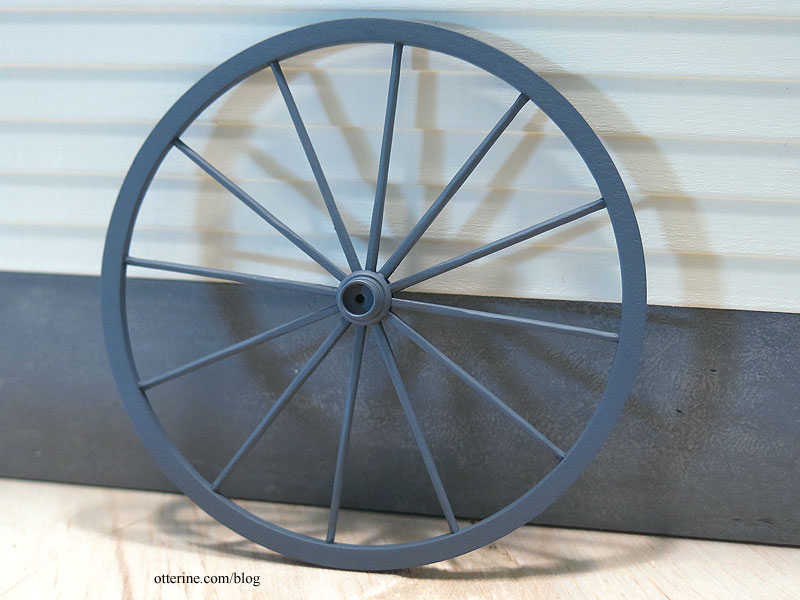
Back to the cabin. I made a drawing for the front based on my built walls, not the previously drawing of the sides. My final measurements for the sides ended up being different from how I had drawn them.
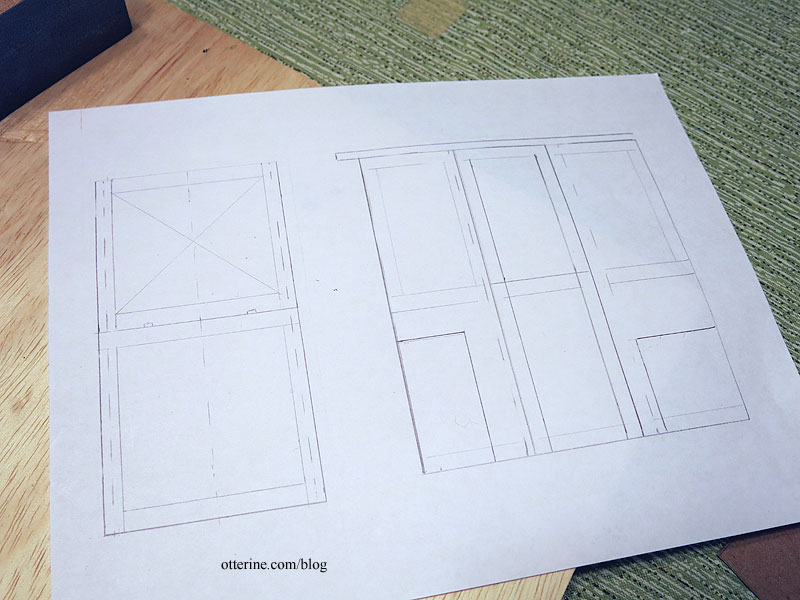
Before continuing, I cut the front and back from cardboard to get a feel for the final size. Easier to adjust here than after I started building the front hinged window.
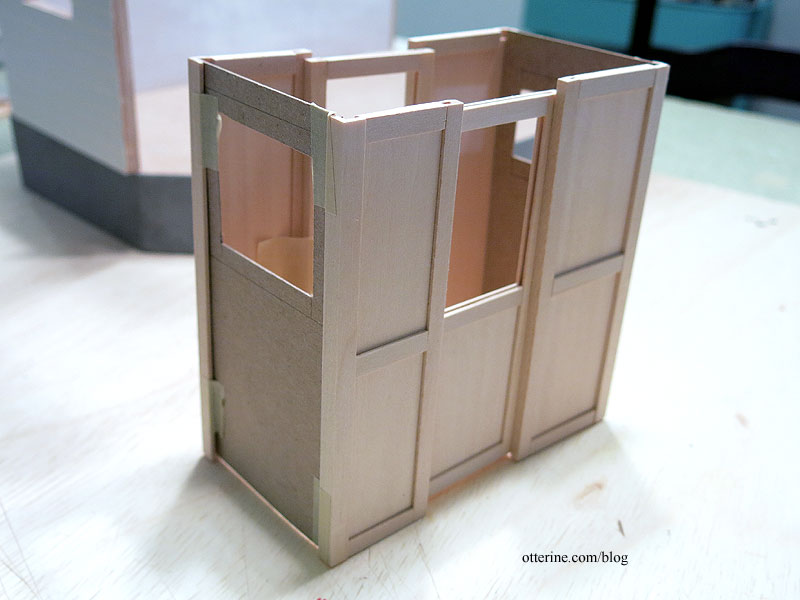
I checked the width against the rear axle assembly, which can be adjusted to fit, but I think the cabin size is good for proportion.
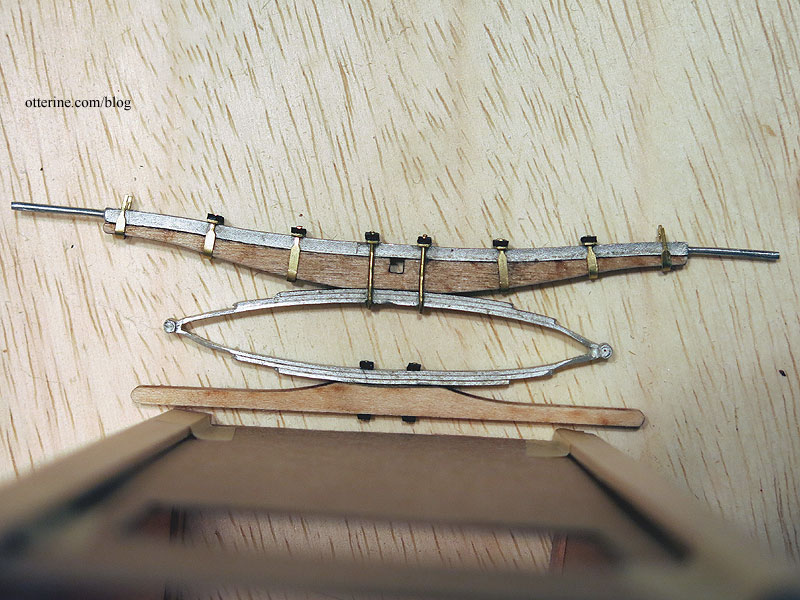
Categories: Ivy Hollow RFD, Model Cars, Vehicles
September 21, 2019 | 0 commentsIvy Hollow – potbelly stove, part 4
Continuing work on the potbelly stove. There’s always the kit stovepipe, which has excellent detailing, but I wanted to attempt a straight pipe up through the ceiling, which would be more in line with my inspiration photo. The rub lies in the oval opening at the rear of the stove. I can’t just take a round polystyrene tube and use it out of the package. I also don’t want to alter the kit parts just in case my alterations fail and I need to fall back on the original stovepipe. As a reminder, here is the stove built for Baslow Ranch.
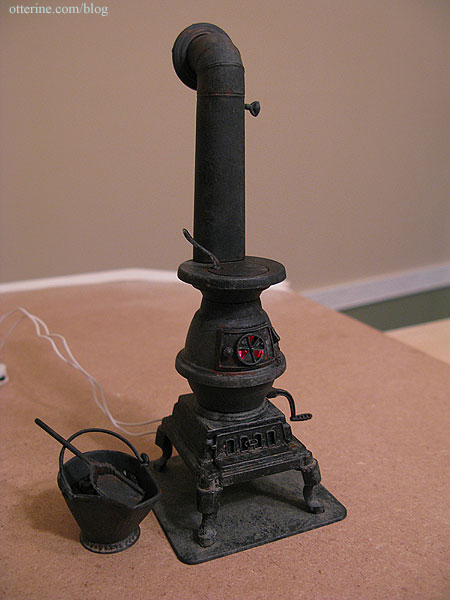
Debora sent me some defunct Chrysnbon kits for parts some time ago, and one of those was the cook stove. Look here at this part. It’s an oval to round adapter.
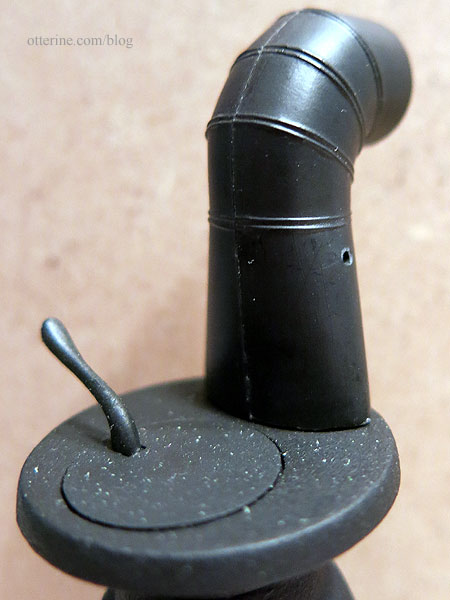
I cut the top away using the scroll saw and sanded it smooth.
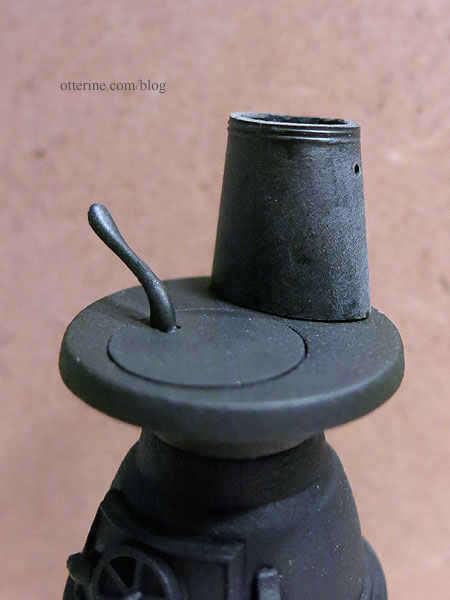
To make the stovepipe that will continue upward, I used 1/2″ polystyrene tubing.
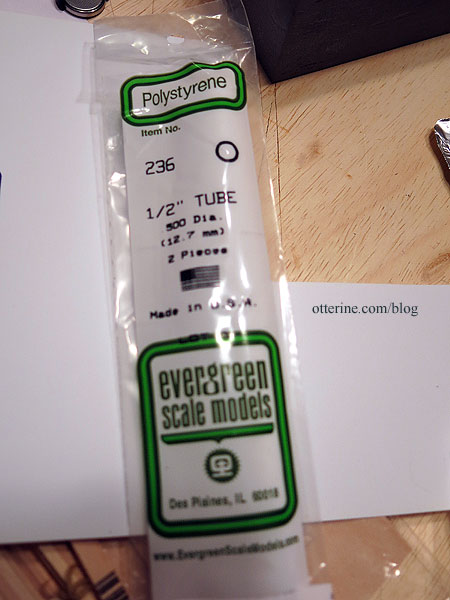
In order to make it easier to hold the stovepipe steady while the plastic cement set, I glued three polystyrene rods inside the pipe adapter.
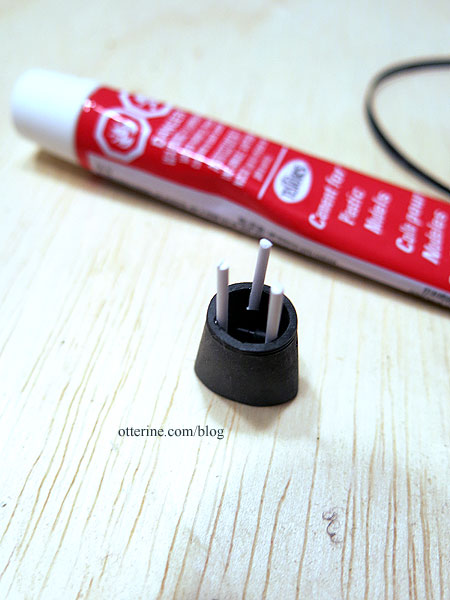
Once the glue set, I glued on the stovepipe, leaving the full length intact. Once I get to the roof, I’ll cut the top angle and fashion a chimney pipe for the exterior. I cut a thin band of polystyrene and glued it approximately 3 inches from the top of the adapter to make it look like the stovepipe was assembled in two pieces, which it likely would have been.
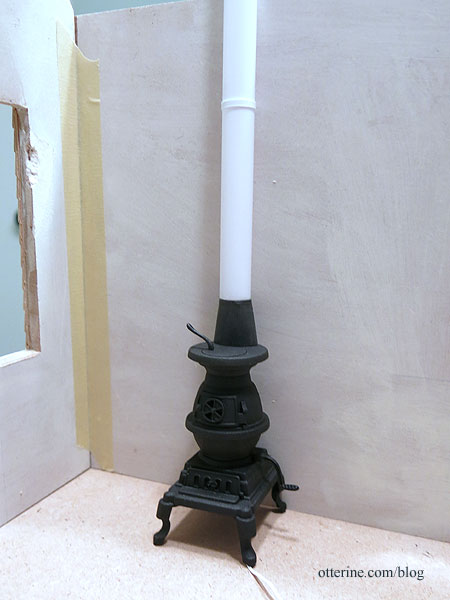
I roughed up the surface with sandpaper and spray painted it flat black. It will remain unattached until installation.
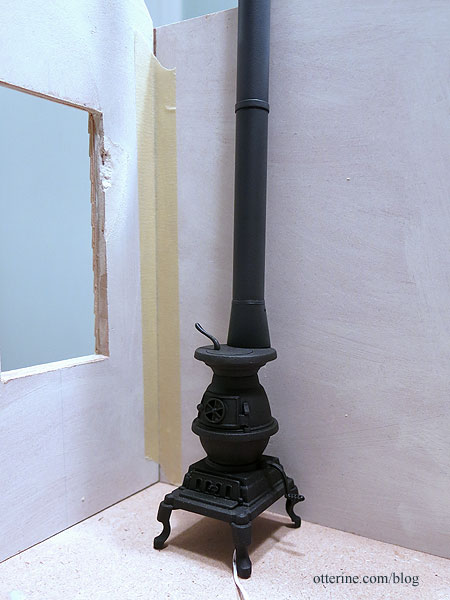
While I was painting, I finished the floor pad in the same stippled black finish as the stove.
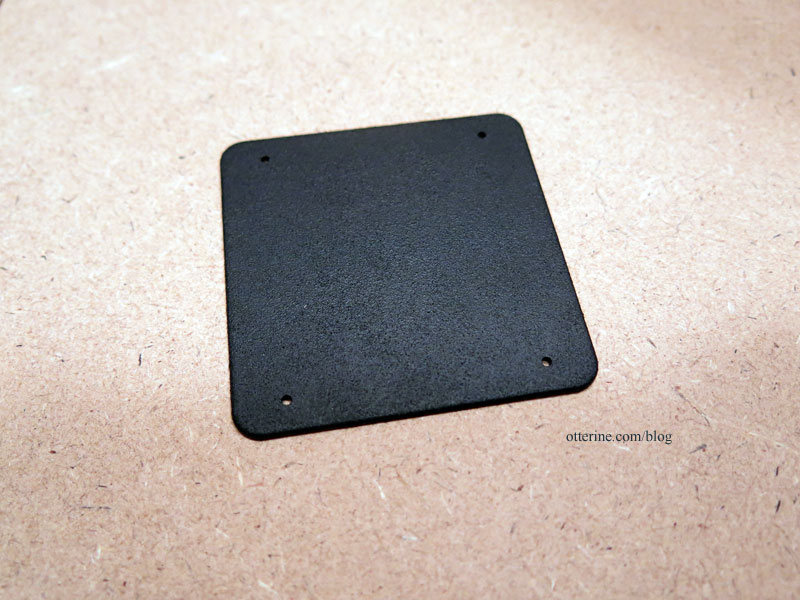
Categories: Ivy Hollow RFD
September 15, 2019 | 0 commentsHorse Harness – part 1
Maybe that should read, “Putting Jebediah to work, part 1.” As you know, I’m using a Breyer thoroughbred horse for my mail wagon. I found it interesting that at least one pacer (harness racing horse) pulled a mail wagon in real life.
 Mail Wagon Horse Mon, Jan 19, 1914 · The Star Press (Muncie, Indiana) · Newspapers.com
Mail Wagon Horse Mon, Jan 19, 1914 · The Star Press (Muncie, Indiana) · Newspapers.comAfter finally getting my hands on the marvelous book Making Model Horse Harness by Anne Funnell, I started reading the material and doing more sleuthing online. Anne’s business is no more, so I am doing my best to scout Rio Rondo for the things I need. They seem to be well-stocked, so I am making a shopping list while I work on a mockup.
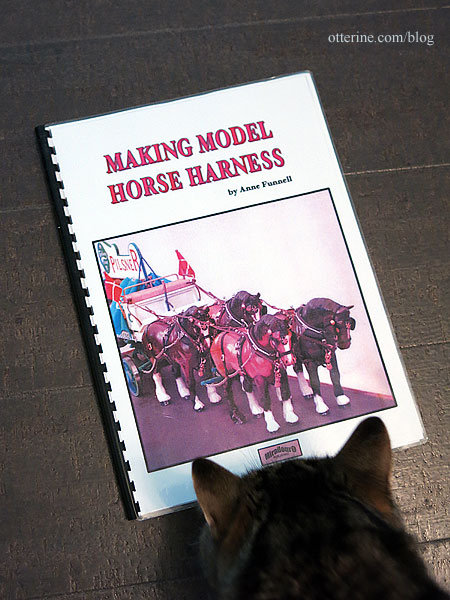
I bought this bridle from Texas Tiny at the local mini shows this past spring.
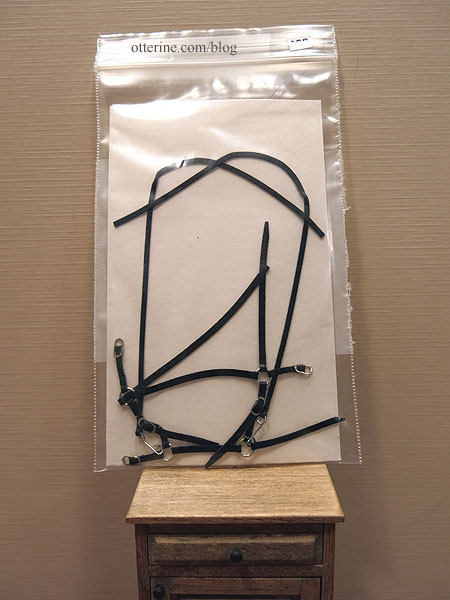
I fitted it to Jebediah to see. Yeah, it was a pain. I can see there will be more swearing in my future as I make said harness. But, it fits perfectly and is very well made. I’m not sure if I will be able to modify this one (the reins are not long enough, there’s no simulated bit and there are no blinders), or if I will have to use this as a guide to make my own with the harness.
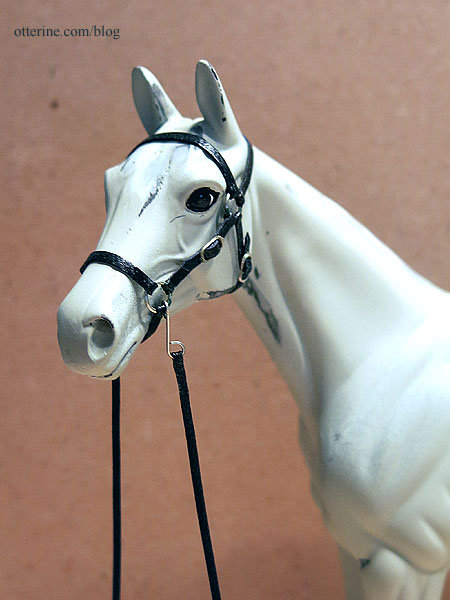
I had the idea of doing a test run with ribbon before diving into the leather and custom hardware. This would give me a feel for the parts and lengths/widths of the tack. Michaels is always hit or miss in the supplies department, but it was the closest store while out to lunch. I bought 1/8″ wide white ribbon – the two colors missing from the stock of plain 1/8″ ribbon were brown and black. I colored the white ribbon with a permanent marker and let it dry overnight. I had 1/4″ black ribbon already at home. These aren’t the precise widths I’ll need, but they are a good approximation.
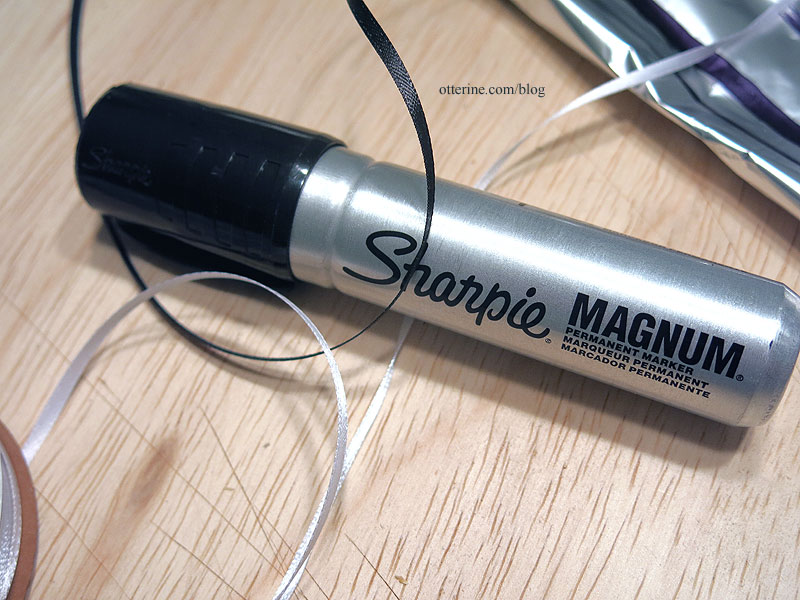
I didn’t get very far, since one part really depends on another, but it was worth a shot. I need to just get the materials and start to work – trial and error. But, this attempt did help me study the drawings in better detail and estimate the amount of leather I will need. I also kept a tally of the various hardware components since the book doesn’t have a detailed listing of items with sizes. The book appears to be a companion to the kits and hardware sold by Anne Funnell, so that is understandable. If you have the kit, you need only the part number – not the size. The kit itself would have likely had a parts list with sizes and lengths noted.
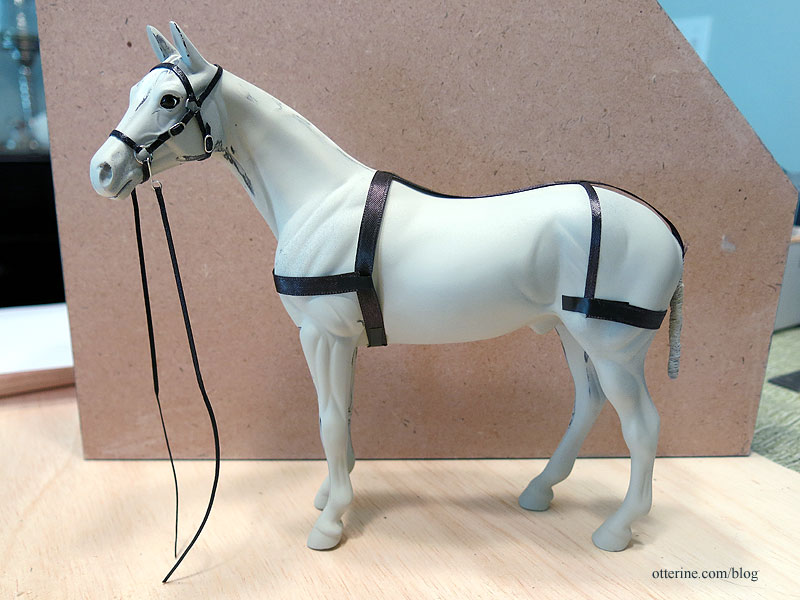
I am reconsidering adding flocking to Jebediah in seeing how much handling needs to be done when attaching and tightening the buckles. I know I can get a good approximation of hair on the body with paint, and the mane and tail will no longer be plastic to help drive the realism.
Categories: Animals and birds, Ivy Hollow RFD
September 14, 2019 | 0 commentsIvy Hollow – inspiration photo and history
As you recall, when I first started with my idea of building a Rural Free Delivery mail wagon and its post office hub, I found this postcard from 1917 showing a post office with RFD horse wagons picking up the mail. It was precisely the type of building I was after. Stevens, PA is the name of the town on the sign above the door, and there’s a short wiki page on the town. After all this fascination, I ended up buying this postcard. :D
It’s a very interesting piece. The print is almost like a daguerreotype on paper. It has that weird metallic shimmer at a certain angle. Here’s an interesting article on the history of postcards I ran into along the way.
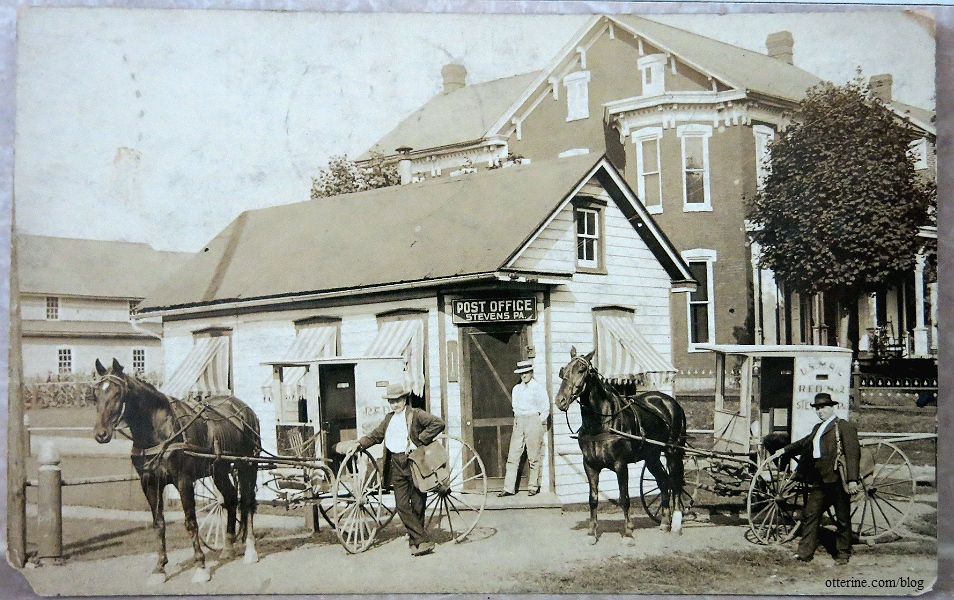
After our lively discussions on the roofing material, which I think we all agree is some type of metal, likely corrugated, I went down a rabbit hole – then explored the whole rabbit warren! It started with a link that Marilyn sent me on historical photos from the Library of Congress (now another research go-to along with Wiki).
To help with my research, I went to newspapers.com and signed up for a membership to peruse old articles. Since Rural Free Delivery was new, along with its aches and pains of growing with the times, there were a number of articles on these pioneering carriers, their professional and personal lives, the service in general and the related news about town.
Sat, Nov 4, 1916 – 8 · The Inquirer (Lancaster, Pennsylvania) · Newspapers.com
During the course of my research, I ended up figuring out who wrote the RFD postcard I bought (postmarked Nov 14, 1917) and to whom it was addressed. The text reads, “I just found a card with the old P. Office so I thought you would like to see where you were still doing the office work. It is rather soiled but the other side is alright. We are well. Hope you’re the same. Mother.”
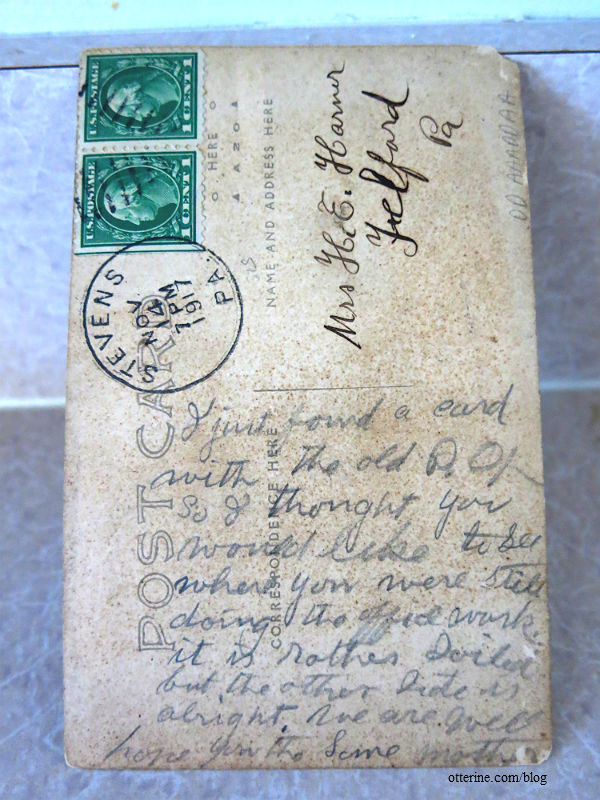
It is addressed to Mrs. H. E. Harner in Telford, PA. I found a 1907 clipping stating the engagement of Emma Clare (or Claire in another clipping) Lutz to H.E. Harner, who was a pastor. Emma’s parents were Mr. and Mrs. Charles S. Lutz.
 Tue, Dec 24, 1907 · Reading Times (Reading, Pennsylvania) · Newspapers.com
Tue, Dec 24, 1907 · Reading Times (Reading, Pennsylvania) · Newspapers.comIt’s hard to find the first and maiden names of wives in old clippings unless it’s an obituary or marriage notice. I found the 1972 obituary of Emma C. Harner, and it identified her parents as Charles S. Lutz and Lydia Mohler. We also finally see her husband’s first name of Harvey. All articles I had researched to this point referred to him only as H.E. Harner.
 Sat, Nov 4, 1972 · Pottsville Republican (Pottsville, Pennsylvania) · Newspapers.com
Sat, Nov 4, 1972 · Pottsville Republican (Pottsville, Pennsylvania) · Newspapers.comThe postcard’s author, Lydia Mohler Lutz, died in 1947 at the age of 93.
 Thu, May 1, 1947 · Pottsville Republican (Pottsville, Pennsylvania) · Newspapers.com
Thu, May 1, 1947 · Pottsville Republican (Pottsville, Pennsylvania) · Newspapers.comSince we know the name of the post office in the photo, I started researching the Lancaster, Pennsylvania area. I stumbled upon a card catalog entry from The Historical Society of the Cocalico Valley. The card in question was labeled, “Stevens Post Office, Stevens, PA; Stevens Post Office with two mail carriers and delivery wagons, n.d., c. 1900.” Well, if that didn’t end up being the exact photo used for the postcard, then it would have to be from the photographer standing right next to the person who took the postcard picture! haaaaaa
I called up the historical society, and Cynthia, the Society’s librarian, looked up the photo and also found another of a mail carrier with his wagon. I was able to get scans of both. The photo subject was indeed the same, though cropped differently. The quality was about the same as the postcard since it was a copy of the photograph and not the original print, but she was able to scan it at a high resolution to bring out even more detail.
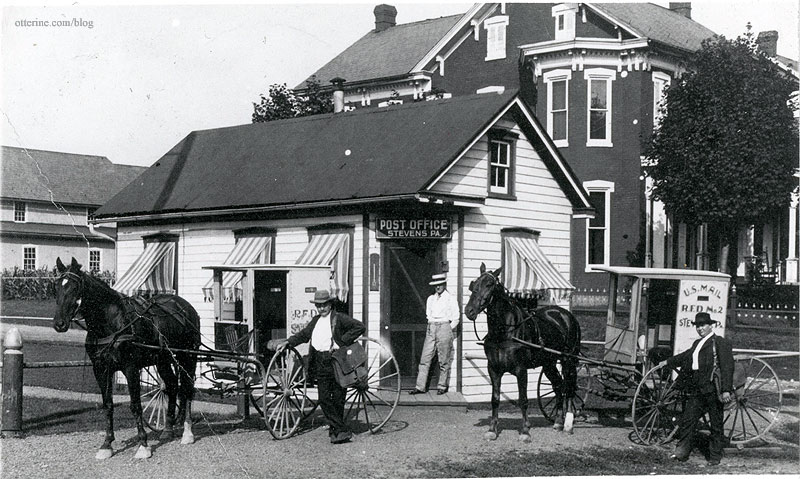
I’m pretty sure that roof is corrugated metal, with uniform panels…or uniform panels with raised metal beams interspersed.
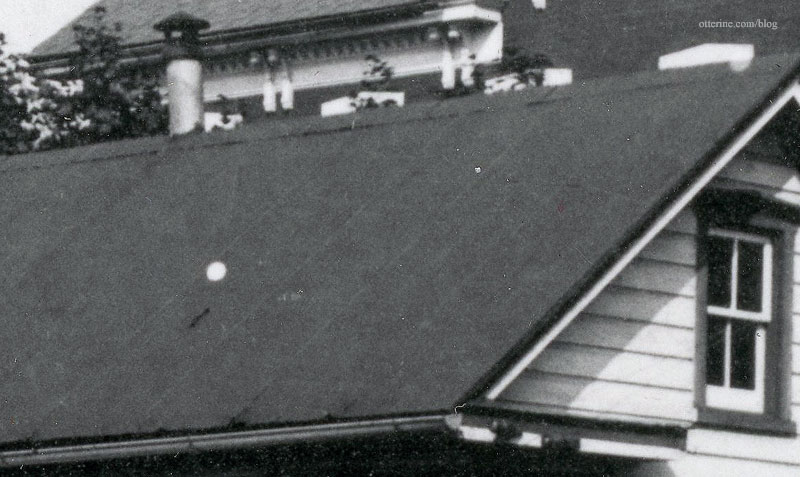
The mail wagon appears to be the same as in the postcard photo – route No. 2. She said there was no name written. The carrier for Route No. 2 could be the same man in the post office photo, but I’ll get to his identity in a moment.
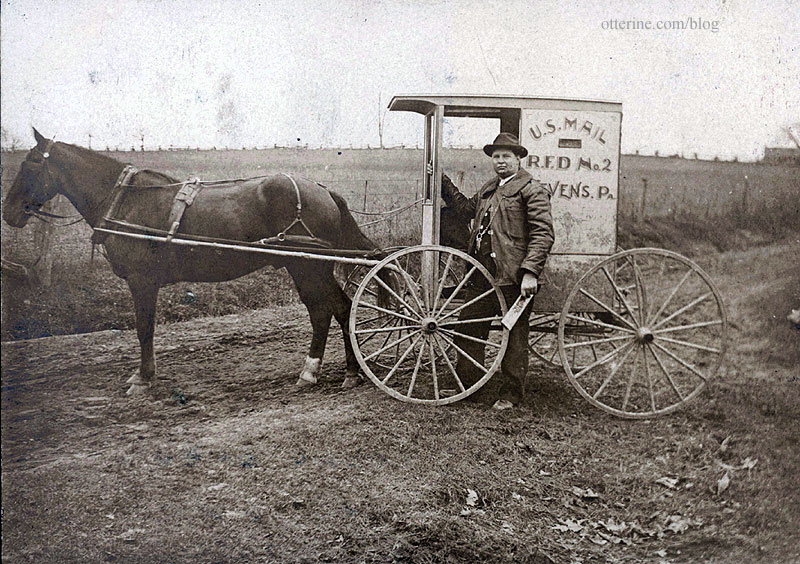
I asked Cynthia about the large brick house behind the post office, figuring it might still be standing. She said the house was the home of J. Frank Lutz, once the postmaster of Stevens, who she thought was the publisher of the postcard. She mentioned the house is still standing though it has been renovated. As expected, the post office building is long gone.
With the Lutz name to search, I found a September 2011 newsletter from The Lancaster County Postcard Club. On page four, there is the same image from the 1917 postcard (theirs is indicated as mailed in 1910) as well as an old map from 1899 of Stevens and other photos of the area. While the newsletter writer seemed uncertain whether the person standing in the doorway was in fact J. Frank Lutz, the two carriers were definitively named as Harrison Z. Enck (route No. 1 – 28.5 miles) on the left and Harry R. Ludwig (route No. 2 – 25 miles) on the right (no names were given for the horses, unfortunately). I tried to obtain more info from the newsletter club, but they have not replied to my inquiries.
I found a photo of J. Frank Lutz dated March 7, 1924, and it could be him in the RFD postcard based on this likeness. On a side note, I had a hard time figuring out the relationship, if any, between Emma Lutz, her mother Lydia Mohler Lutz and J. Frank Lutz. It seems it was common to use the same first names across families and areas, making it difficult to differentiate who was who.
 Fri, Mar 7, 1924 · Intelligencer Journal (Lancaster, Pennsylvania) · Newspapers.com
Fri, Mar 7, 1924 · Intelligencer Journal (Lancaster, Pennsylvania) · Newspapers.comThe newsletter writer mentions the building in the back left as a painting and carriage repository that was also the property of Mr. Lutz. As of the 2011 newsletter, it was noted that the shorter of the two buildings shown in the original postcard still stands as a storage shed. I was able to find the same postcard (unused) of the hardware store and adjacent buildings for a reasonable price online.
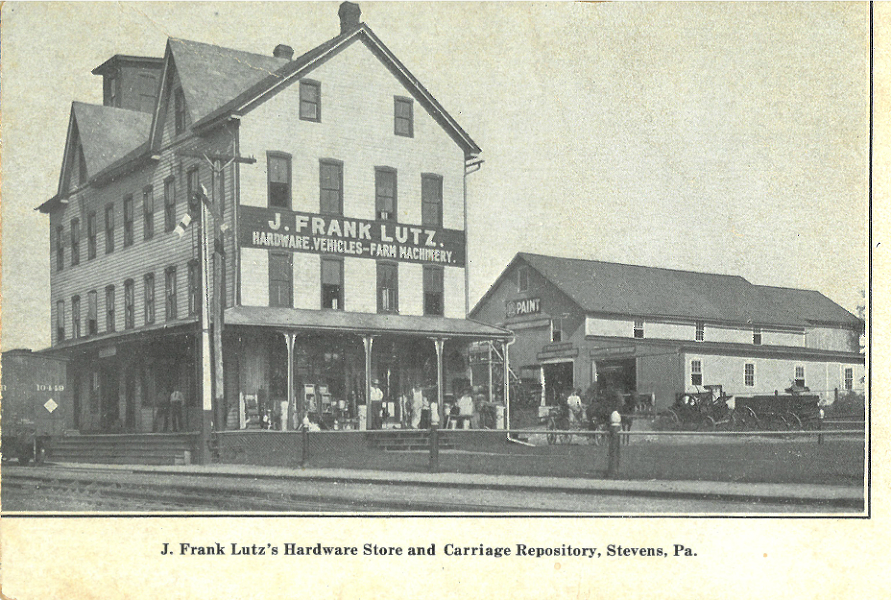
I typed the current address Cynthia gave me into google maps, and I think I found what remains of the three buildings. Maybe? Brick to siding for the house? The shed building looks very similar, and it is right on the railroad tracks. Seems like the right location.
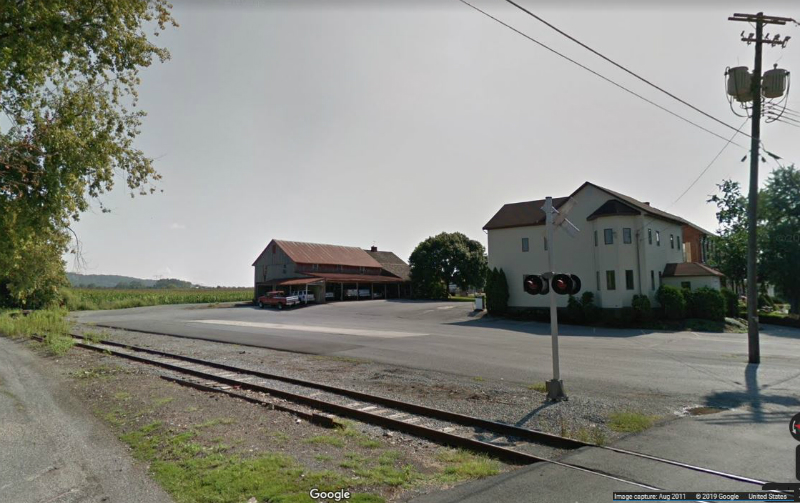
On page five of the newsletter, there is another photo of the post office they indicate as dated 1907-1909 showing the hardware building and the post office right on the railroad tracks. Look, no window awnings! :D I was able to track that photo back to this website, but the site owner had no other information on it. The Stevens/Reamstown station description on that website mentions the Lutz Hardware Store and Carriage Repository, indicating this railroad station started as a small platform for a dairy farmer and that the building was originally owned by J.S. Heiser before becoming the Lutz Hardware Store.
It’s strange, though, because there are a few differences besides the awnings. There is no sign on the Lutz Hardware building, the post office sign doesn’t seem to mention the town name as it does in the RFD postcard, and the door is also different. The building seems closer to the railroad, or at least the easement, which can’t be seen in the RFD postcard but there is more area and a short post between the building and the utility pole in the RFD postcard. So, it’s hard to tell if this is an earlier or later photo. It seems as though it would be later since it is more likely the railroad easement would encroach on an existing building than more space being added after the railroad was in place. Regardless of the time relation to the RFD postcard, I think it’s pretty awesome to have found a second photo of the same tiny post office.

image from West2K, used with permissionI found this notation stating Mr. Lutz was born November 22, 1872 (died October 19, 1959 – aged 86) and never married. The article doesn’t mention his being a postmaster, but it does mention the hardware store and carriage repository. It seems Mr. Lutz got himself into trouble for postal money order fraud and spent some time in jail around 1941.
 Wed, Mar 26, 1941 · Intelligencer Journal (Lancaster, Pennsylvania) · Newspapers.com
Wed, Mar 26, 1941 · Intelligencer Journal (Lancaster, Pennsylvania) · Newspapers.comI found a book called The Zartman Family by Rufus Calvin Zartman (dated January 1, 1909) showing a brief history on Mr. Enck. It references his job as a rural mail carrier.
There was a lovely write-up about Mr. Enck in a 1925 newspaper titled Traveled 200,000 Miles in 21 Years as a Rural Mail Carrier; he was noted as being 68 years of age at the time the article was written. It mentions his starting the rural route No. 1 in Stevens and says he carried over 600,000 pieces of mail without missing one. The photo in the article is noted as being of his first horse and mail wagon. Hard to tell if it matches the RFD postcard photo.
 Sun, Jun 21, 1925 · Sunday News (Lancaster, Pennsylvania) · Newspapers.com
Sun, Jun 21, 1925 · Sunday News (Lancaster, Pennsylvania) · Newspapers.comThere was conflicting information on the second carrier in the original RFD postcard photo. I found a clipping from 1903 announcing the start of the two rural routes in Stevens, PA – scheduled for March 2, 1903. This clipping mentions the driver of route No. 2 as Harry H. Shirk (not Harry R. Ludwig).
 Sat, Feb 21, 1903 · The Inquirer (Lancaster, Pennsylvania) · Newspapers.com
Sat, Feb 21, 1903 · The Inquirer (Lancaster, Pennsylvania) · Newspapers.comIn a May 13, 1922 Letter to the Editor written by Harry R. Ludwig, he mentioned he had been a rural letter carrier for 16 years, which indicated a start around 1906. It’s not clear if the man in the RFD postcard and the other photo is Harry R. Ludwig or Harry H. Shirk. The 1922 letter had a photo of Harry R. Ludwig. Hard to tell without a photo of Harry H. Shirk, which I could not find, but the men in the photos do have a similar build. In my research, I found two different men with the name Harry H. Shirk, and neither was referenced as being a mail carrier so I couldn’t tell which was the right one.
 Sat, May 13, 1922 · The News-Journal (Lancaster, Pennsylvania) · Newspapers.com
Sat, May 13, 1922 · The News-Journal (Lancaster, Pennsylvania) · Newspapers.comConsidering the rural routes in Stevens, PA began March 2, 1903 and the RFD postcard was mailed in 1917 (and the writer calls this the “old” post office), the photograph had to be taken in the time frame of 1903 to 1917. Also, the 2011 newsletter references their identical postcard as being mailed in 1910, which would narrow it down to 1903-1910. Articles pertaining to Harry R. Ludwig (written by Mr. Ludwig himself) indicate he began his RFD career in 1906. My guess is the photo was taken right when the RFD routes started in 1903 or soon after, and so it’s likely not Harry R. Ludwig in that photo. But, could he be the man in the other RFD No. 2 photo? The wagon is certainly more worn in that photo than the original RFD postcard. I guess we’ll never know.
In a clipping from May 2, 1921, it was noted that Mr. Ludwig fractured his arm cranking his automobile. I wonder if he ever injured himself using a horse wagon.
 Mon, May 2, 1921 · The News-Journal (Lancaster, Pennsylvania) · Newspapers.com
Mon, May 2, 1921 · The News-Journal (Lancaster, Pennsylvania) · Newspapers.comMr. Ludwig was born November 6, 1879 and died in 1927 at the age of 47.
 Sun, Mar 6, 1927 · Sunday News (Lancaster, Pennsylvania) · Newspapers.com
Sun, Mar 6, 1927 · Sunday News (Lancaster, Pennsylvania) · Newspapers.comMuch of historical research is guesswork, because newspapers and the like can be filled with errors, and finding the retractions and corrections isn’t always easy. But, I had a lot of fun getting this far – all starting with a simple google search that landed on an antique postcard. And, reading old newspapers is a real hoot!
 Sat, Mar 18, 1905 · The Philadelphia Inquirer (Philadelphia, Pennsylvania) · Newspapers.com
Sat, Mar 18, 1905 · The Philadelphia Inquirer (Philadelphia, Pennsylvania) · Newspapers.comDo I usually go through this much research during a build? You can ask anyone who has been behind the scenes before to confirm, but the answer is absolutely yes! :D To me, part of the enjoyment is immersing myself in the life and times.
Categories: Ivy Hollow RFD
September 11, 2019 | 0 commentsMail Wagon – part 9
Continuing work on the mail wagon. I’m planning a basic box cabin with trimmed details, a hinged front window, and sliding side doors. I’m using 3/64″ thick basswood sheets (3″ x 24″) for the majority of the parts. It’s thinner than 1/16″ and therefore lighter in weight but still durable when trimmed.
I started by drawing a quick sketch using the Rondel kit sides as a starting point, then refining from there based on measurements for average seat height, the seated height of my artist model and general proportions from the various mail wagon examples I’ve reviewed.
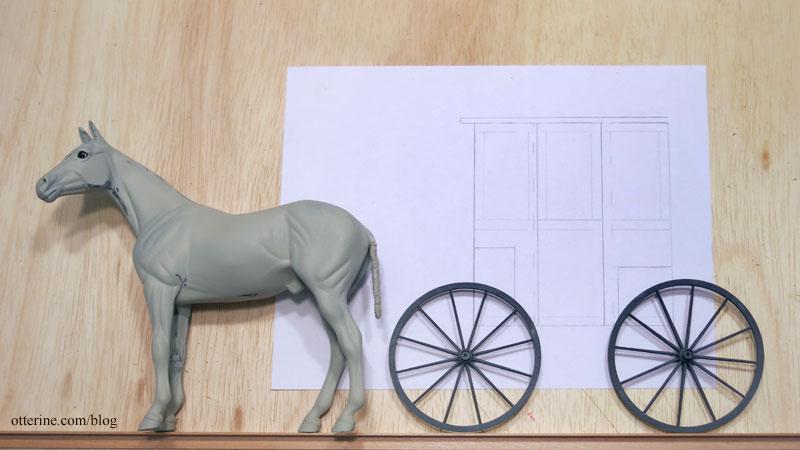
The two doors are where I will begin, then I can build the walls to enclose around them. If these don’t work, then my basic construction will change since I’ll make hinged doors instead. I’m using door frames from Northeastern Scale Lumber, cutting them down width-wise. I am sure there must be a place to get the window channel that Houseworks uses to make their windows, but I have yet to discover it.
The door frame material holds the 3/64″ thick basswood perfectly as an insert, and 3/64″ thick trim finishes the frame. The top will have acrylic sheet for the window. As I was working, I decided to make my door a little wider than my drawing for practicality. This will add a modest amount to the length of the wagon, but it seemed necessary for better proportion. Here is one door with the original width of door frame material on the side and the other with the width cut down.
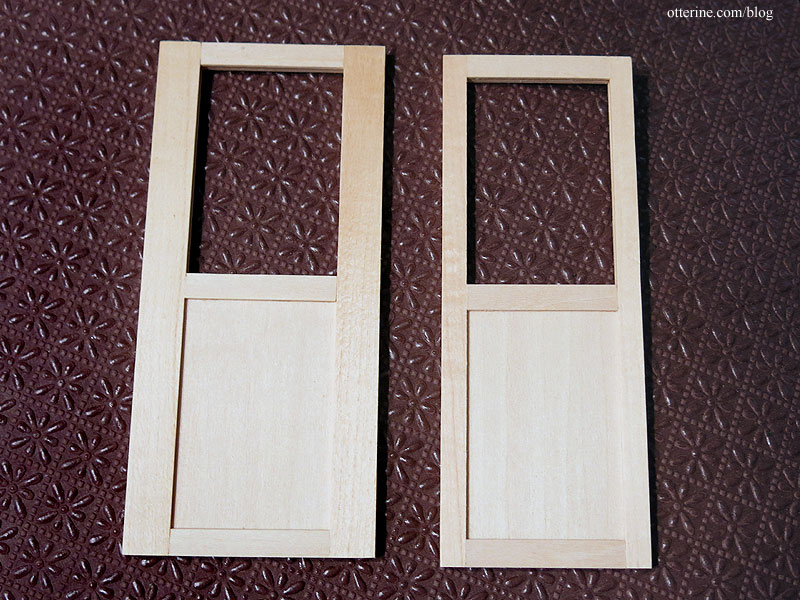
I built the side front and side back walls using the door frame material for the lead edge of the door openings as well as the tops and bottoms, cut down to size width-wise. I used 1/4″ corner trim for the front and back edges to make it easier to join the front and back of the cabin when I get to that stage.
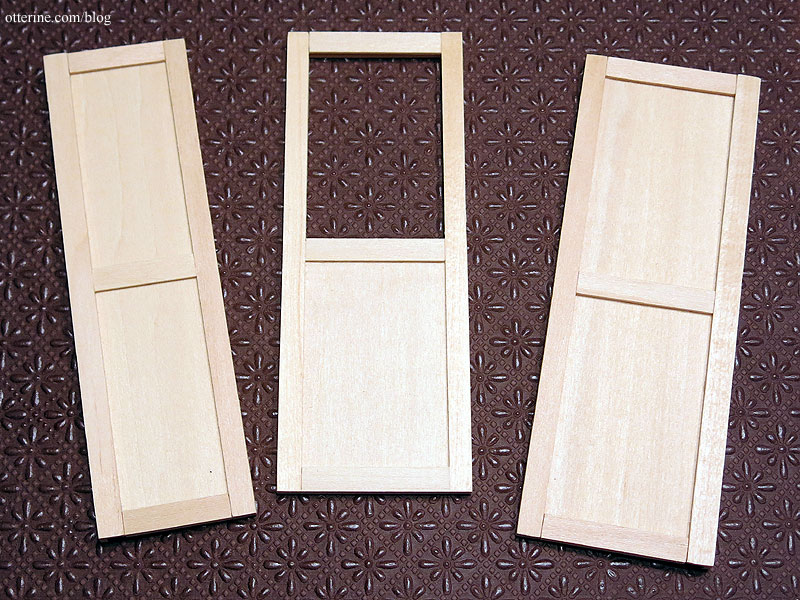
Most of the examples I saw had no side windows, sometimes small slits to peer through, so I’ve left the side walls solid to have more room for the lettering. The cross trim on the side front and side back panels isn’t glued in place yet, since I want it to line up with the door in the end. Leaving it unattached allows for adjustment later.
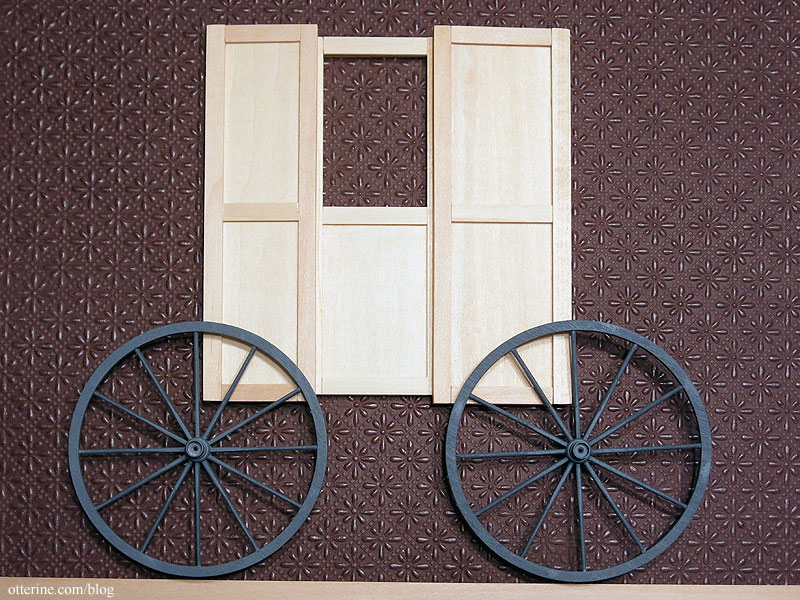
Each door will slide to the back just short of its door handle.
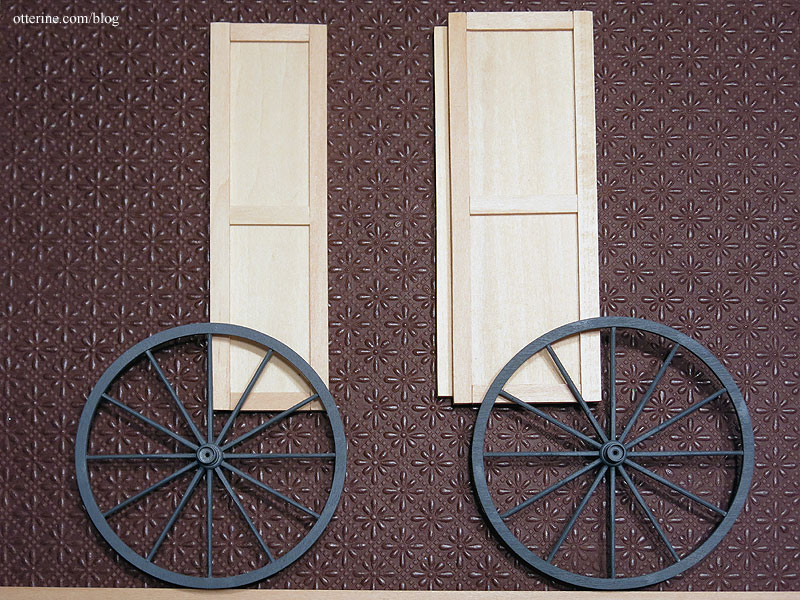
I think this will work well, so next I will make the front, back and floor.
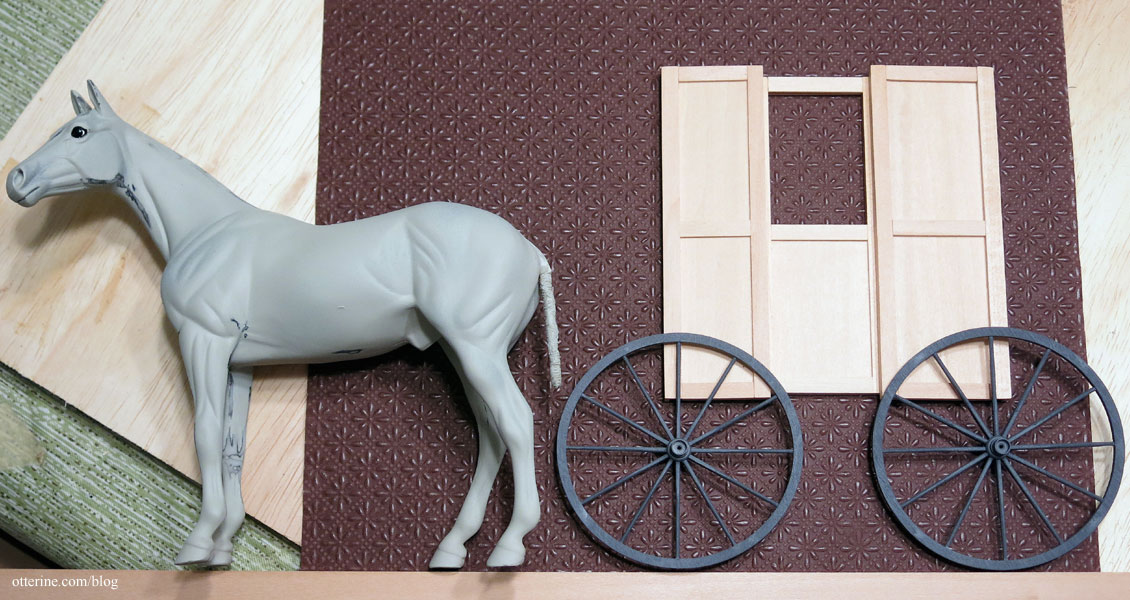
Categories: Ivy Hollow RFD, Model Cars, Vehicles
September 8, 2019 | 0 comments
NOTE: All content on otterine.com is copyrighted and may not be reproduced in part or in whole. It takes a lot of time and effort to write and photograph for my blog. Please ask permission before reproducing any of my content. (More on copyright)



